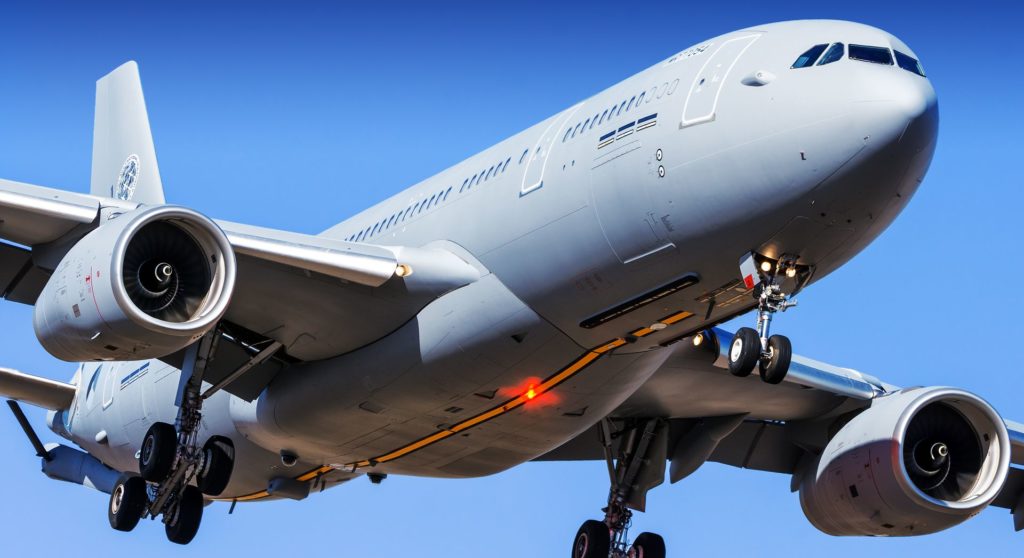Estimated reading time 4 minutes, 44 seconds.
Only one bidder has qualified so far to provide the Royal Canadian Air Force (RCAF) with its next strategic transport and air-to-air refueling aircraft.
Public Services and Procurement Canada (PSPC) on April 1 released a list of qualified suppliers to participate in the next phases of the RCAF’s Strategic Tanker Transport Capability (STTC) project, and only Airbus Defence and Space and its A330 Multi Role Tanker Transport (MRTT) made the cut.

Boeing and the KC-46 Pegasus, a militarized variant of the 767 widebody, was informed the aircraft did not qualify for the project to replace the current fleet of five CC-150 Polaris aircraft.
The decision does not entirely eliminate the KC-46 from future consideration. In posting the qualified supplier list, PSPC said the government “may, at its sole discretion, re-open” the invitation to qualify phase and share documents with any new entrants.
In a statement, Boeing said it was disappointed with the decision, but “we will remain ready to bring the full depth and breadth of Boeing to our offer in the event Canada decides to reopen the bidding process.”
The company noted that the “KC-46 offers superior interoperability, supportability, and affordability along with a robust industry plan that would bring real, guaranteed jobs to companies all across Canada. With 183 aircraft on order and growing international interest, we expect the global fleet to surpass 200 aircraft by 2029.”
Airbus has offered the A330 Multi Role Tanker Transport (MRTT) aircraft, which the company called “the only new generation, combat- proven, multirole tanker available.”
“It is certified to operate with the majority of western receivers, including Canada’s current fighters, transport, and mission aircraft,” Simon Jacques, president of Airbus Defence and Space Canada, said in a statement.
The A330 MRTT has over 250,000 flight hours with 13 nations, “including key NATO allies and Five Eyes partners such as Australia and the United Kingdom,” he noted.
The government’s invitation to qualify was issued on Feb. 12 to identify respondents able to meet the STTC project’s security and other core requirements before moving to the tender phase. Only qualified suppliers will be invited to participate in workshops and one-on-one sessions to refine the aircraft requirement and respond to an eventual request for proposals to be issued by fall 2021.
The RCAF is seeking a multi-role platform that can be configured for air-to-air refueling, personnel airlift, strategic government transport, aeromedical evacuations, and freight movement, among other roles. The aircraft may also be used to support disaster relief, search-and-rescue and contributions to peace operations; it must also include the capacity to detect, avoid, and defeat air-to-air and ground-to-air threats. In its tanker role, the aircraft must be able to refuel allied fighter jets on NATO and NORAD operations.
The current fleet of CC-150s, a modified variant of the Airbus A310-300, were acquired in 1992 from Canadian Airlines, and two were converted to tankers in 2008. The fleet is operated by 437 Transport Squadron at 8 Wing Trenton, Ontario.
The government has engaged BDO Canada as a fairness monitor for the procurement, PSPC said.









Is there some reason why we aren’t just buying and converting any of the aircraft already available out there on the secondary market? Worked well enough with the Polaris.
If I recall correctly, the government was talking with Air Canada and other airlines to see if anyone would be willing to sell some of their Airbus A330s during the pandemic. From the looks of it, they didn’t find a willing seller.
Sure you can do that but you have to consider the cost of converting an old aircraft, more maintenance and a much shorter expected long life. If you have to replace the aircraft in 10-15 years I don’t know if you really saved any money. Think life cycle cost to really know what is the best option.
Polaris (A310 MRTT) was based on converted commercial A310 airframes. Production of the type ceased in 1998. The existing fleet will be fairly old by now and probably are nearing the end of their cyclic life
A330 MRTT, similarly, are also based on commercial A330 airframes, but the crucial difference is that the type is still in production, and you can still buy them.
Those Polaris were new or almost. Most of what is out there on the market has the living crap flow out of it and would require extensive and expensive mods to bring them to military standards. Better off with new purpose built aircraft
Not surprisingly Boeing not qualified. KC-46 is a disaster for the USAF. FOD and other quality issues. Cost and schedule is blown past original plans. Canadian government still hasn’t forgotten about the CSeries tariffs.
Wants vs needs…early days in this procurement.
So make the decision. Do not cater to Boeing or these US companies. The UK and Australia are happy with Airbus and the US Air Force unhappy with Boeing. What does that tell us?
Couldn’t have said it better!
Bloody well said. KC46 is a disaster in all regards.
Even now that they entered “partial” service, they prove to be a failure.
This is a genuine question : How can you make a tanker that is unable to refuel anything ? Well, pardon my harshness, but if you’ve ever wondered, I’ll advise you to seek for Boeing’s guidance, because as of now :
Only two KC-46s entered limited use in the USAF, 7 years after the first flight.
And still, they aren’t allowed to refuel A-10s because of boom issues, and cannot see F22, F35 and B2s at night because of their horrible camera system.
There is little to no competition to the MRTT as things stand right now. Because compared to it, the so-called ” superior interoperability, supportability, and affordability” is yet to be seen.
Regards.
there must be a ton of farily good 330’s availon the market now.